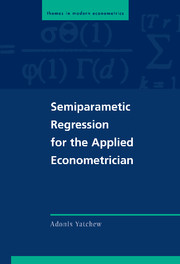Book contents
- Frontmatter
- Contents
- List of Figures and Tables
- Preface
- 1 Introduction to Differencing
- 2 Background and Overview
- 3 Introduction to Smoothing
- 4 Higher-Order Differencing Procedures
- 5 Nonparametric Functions of Several Variables
- 6 Constrained Estimation and Hypothesis Testing
- 7 Index Models and Other Semiparametric Specifications
- 8 Bootstrap Procedures
- Appendixes
- References
- Index
5 - Nonparametric Functions of Several Variables
Published online by Cambridge University Press: 15 December 2009
- Frontmatter
- Contents
- List of Figures and Tables
- Preface
- 1 Introduction to Differencing
- 2 Background and Overview
- 3 Introduction to Smoothing
- 4 Higher-Order Differencing Procedures
- 5 Nonparametric Functions of Several Variables
- 6 Constrained Estimation and Hypothesis Testing
- 7 Index Models and Other Semiparametric Specifications
- 8 Bootstrap Procedures
- Appendixes
- References
- Index
Summary
Smoothing
Introduction
In economics it is rarely the case that one is interested in a function of a single variable. Moreover, even if one is comfortable incorporating most of the explanatory variables parametrically (e.g., within a partial linear model), more than one variable may enter nonparametrically. The effects of geographic location – a two-dimensional variable – provides a good example. (Indeed, in Section 5.4.1 we estimate the effects of location on housing prices nonparametrically while permitting other housing characteristics to be modeled parametrically.)
In this chapter we therefore turn to models in which there are several nonparametric variables. A variety of techniques are available. We will focus primarily on kernel and nonparametric least-squares estimators. However, the elementary “moving average smoother” which we considered in Section 3.1 has a close multidimensional relative in nearest-neighbor estimation. Spline techniques have natural generalizations (see particularly Wahba 1990 and Green and Silverman 1994). Local linear and local polynomial smoothers also have multivariate counterparts (see Fan and Gijbels 1996).
Kernel Estimation of Functions of Several Variables
Suppose f is a function of two variables and one has data (y1, x1), …, (yn, xn) on the model yi = f(xi1, xi2) + εi, where xi = (xi1, xi2). We will assume f is a function on the unit square. We want to estimate f(x0) by averaging nearby observations; in particular, we will average observations falling in a square of dimension 2λ × λ, which is centered at x0.
Information
- Type
- Chapter
- Information
- Semiparametric Regression for the Applied Econometrician , pp. 99 - 110Publisher: Cambridge University PressPrint publication year: 2003
